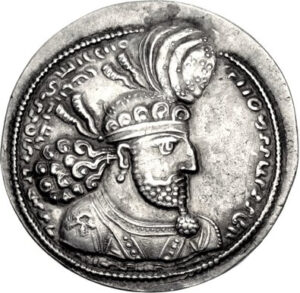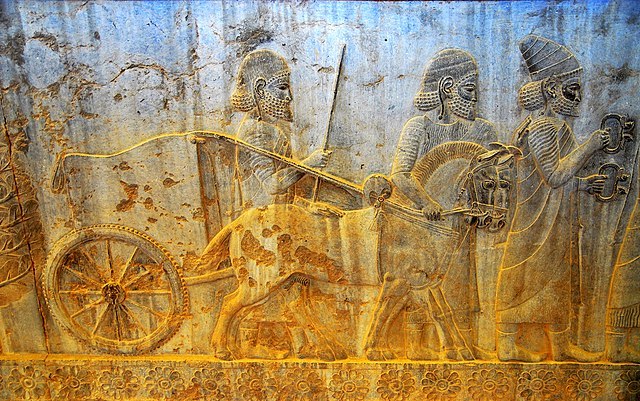
Coin of the Sasanian king Hormizd I, Author Classical Numismatic Group, CCA-SA 3.0 Unported license.
Johnny Hassan is a successful LA entertainment lawyer and sometimes TV producer. He also is a proud Persian American. When he was just a small child, Johnny’s family fled Iran in the wake of the Islamic Revolution. His father had been a successful doctor who practiced in Tehran. His mother was a distant relative of Farah Pahlavi, the Empress of Iran. Like other members of the old elite, Johnny’s father collected antiquities associated with the nation’s glorious imperial past. Luckily, Johnny’s father moved much of the family’s wealth to America before the Shah’s regime fell. That wealth helped the family start over again and pay for Johnny’s schooling at the University of California and Stanford Law School.
Johnny inherited much of his father’s collection. He also built up his own collection of Persian and Sassanian artifacts as well as an almost complete collection of coins depicting the Sassanian Empire’s rulers, each in their own distinctive crown. Johnny’s most prized pieces are a small relief of a Persian soldier he had inherited from his father and a large silver platter depicting a Sasanian king hunting game that he purchased 15 years ago from a well-known New York dealer. He was so proud of both artifacts, that he made sure that they were displayed prominently as the background for a photo taken of him for a profile published in Variety, a trade publication that covers the Hollywood television and film industry.

Persepolis 1930s. The Oriental Institute of the University of Chicago, Photo 61379 / N ° 41057
Recently, out of the blue, Johnny received an email from someone who claimed to work for the Gotham District Attorney’s office “Antiquities Repatriation Unit.” It attached what purported to be a criminal subpoena for a grand jury investigation seeking all documents in Johnny’s possession related to the relief of the Persian soldier and the Sassanian silver platter. At first, Johnny thought it was all a bad joke, but he then recalled another story in Variety about the Gotham DA’s Office seizing an ancient Roman marble sarcophagus owned by a well-known personality and influencer who also lives in California. Johnny remembered reading that the Gotham DA had begun its investigation based on a tip from an activist archaeologist who had achieved some notoriety from such highly publicized seizures. Johnny wondered if the same activist targeted him after seeing those background images of his relief and silver plate in Variety. He also recalled reading in a numismatic publication some time ago about another seizure from a coin dealer, not only of coins allegedly stolen from Italy, but also other coins in the dealer’s possession—some with old pedigrees— that belonged to multiple consigners. He thought, my God, will my coin collection be next?
Johnny decided to consult with his classmate and friend, George Jensen, a lawyer who has a white-collar criminal defense practice. As it so happened, George also had represented the influencer who had given up the Roman marble sarcophagus, so he had some prior experience in dealing with the Gotham DA. Johnny told George all that he knew about the relief and the silver plate. Johnny did not know where his dad purchased the relief depicting the Persian soldier, but he did know it was on loan to a museum in New York City for at least ten years before Johnny inherited it six years ago. Johnny had purchased the silver platter from a dealer in New York about a decade ago. At the time, the dealer gave Johnny a warranty of title and authenticity that included a statement that the item was imported legally into the United States.

Silver plate showing a king hunting lions; judging by his crown the king may be the Sasanian king Varahran V (popularly known as Bahram Gur) reigned AD 420-438, photo 2 December 1988, copyright Trustees of the British Museum.
Johnny then asked his friend how he should respond to the subpoena. He wondered how a prosecutor in New York could subpoena him in California, particularly over items that have been in his possession in California for years. He also wondered why the prosecutor was interested in a relief his dad owned in Iran and a silver platter Johnny had bought from a well-known dealer in New York. As far as Johnny knew, he had good title to both items.
George understood why Johnny would be puzzled, but George had enough experience to know that the Gotham DA’s office’s demands couldn’t just be ignored. George explained that the Gotham DA investigates cases where it suspects that cultural goods were unlawfully removed under foreign laws that declare anything found in that ground to be “state property.” In the US, you own what you find on your own property. In other countries, however, that often is not the case, particularly for those unfortunate enough to live under authoritarian regimes. Moreover, as far as the Gotham DA is concerned, the usual limits on prosecutorial discretion simply don’t apply. More often than not, items are seized and repatriated after having been openly displayed for decades or sold multiple times at public auction. Such seizures are only possible because the DA believes that no statute of limitations applies to “possession” of stolen property. Additionally, the Gotham DA believes that it can assert jurisdiction over any artifact, or any transaction related to that artifact, that passes through the City. And “pushing the envelope” even further, the Gotham DA regularly sends subpoenas out of state in such cases, knowing full well that they have no force outside its jurisdiction.

Sadegh Khalkhali destroys the tomb of Reza Shah, April-May 1980, Wikimedia Commons.
George could only make an educated guess why the Gotham DA was interested in the relief of the Persian soldier and the Sassanian silver plate. George knew that the Gotham DA had seized a similar relief from a British dealer at an antiques fair in Gotham even though that relief had previously been on display at a museum in Canada for years. In that case, the Gotham DA alleged that the relief was illegally removed from the ruins of the Persian Great King’s palace at Persepolis, sometime after such material was declared state property in the 1930s. He also knew that the Gotham DA had taken the position that any object handled by certain antiquities dealers “must be stolen” simply because that same dealer had handled other problematic material in the past. Unfortunately for Johnny, he had purchased the silver platter from the same dealer who handled that repatriated Roman marble sarcophagus. George also told Johnny that while the subpoena he received could not be enforced, the Gotham DA could still try to pursue the matter with the help of federal authorities or even more likely, litigate the matter in the press. George noted that the evidence the Gotham DA had presented to justify repatriating the Roman marble sarcophagus to Italy was “full of holes,” but in the end the influencer decided to give up the piece rather than face a barrage of bad press.

Yazdgard II. 438-457 AD. AV Dinar, “The Mazda worshipper, the divine, the fortunate, Yazdgard” in Pahlavi, Classical Numismatic Group, 28 August 2019, user: Louis Aragon. CCA-SA 2.5 Generic license.
Johnny sat back and thought about some of those police procedurals he worked on that featured overzealous cops. He also was reminded about what his late father had told him about the harsh tactics of the Shah’s Savak and the Mullah’s Revolutionary Guard. After hearing George speak about his own experiences, Johnny wondered if the Gotham DA was cut from the same cloth. Johnny mulled over the matter, and then told George he would need more time to consult with his family before deciding whether to retain George to fight or just give up his treasured antiquities as others had done in the past.
Meanwhile in Tehran, Revolutionary Guard Colonel Vahid Khan received an email from the Gotham DA’s office forwarded to him from the Ministry of Cultural Heritage, Tourism and Handicrafts. The Gotham DA’s email asked Iranian authorities for confirmation that the stone relief of a Persian soldier and a silver platter with a hunting scene being held by a family of Iranian exiles was state property of the Islamic Republic of Iran. On reading the email, Khan smiled before sending a curt response, directing the Ministry to create any necessary paperwork to justify the Islamic Republic of Iran’s claim to the exile’s property. Then, letting his mind wander, Khan pictured himself being honored at a ceremony at the National Museum of Iran where the exile’s repatriated artifacts would be unveiled to high government and Revolutionary Guard officials, maybe even including representatives of the Supreme Leader himself.
Next Installment: Accumulations versus Collections

Maneuver of Iranian Police Protection Units, 11 October 2017, Author Hamed Malekpour, CCA 4.0 International license.
The above story is fictional. For more information about the activities of the real Manhattan DA’s office Antiquities Trafficking Unit, see:
Peter K. Tompa, Repatriation of Brutus Aureus Highlights Dangers of Overzealous NY DA’s Office to Ancient Coin Collecting, Cultural Property News (April 28, 2023)
Rescuing Stolen Art and Antiquities, CBS News, Sunday Morning (March 26, 2023).
Kate Fitz Gibbon, Vance Caps Career: Steinhardt Gives Up $70 Million in Antiquities, Cultural Property News (January 19, 2022)
Angelica Villa, Investigations into New York Financier Michael Steinhardt Reveal Delicate Politics Waged in the Cultural Sphere, Art News (Oct. 25, 2022)
Ariel Sabar, The Tomb Raiders of the Upper East Side, the Atlantic (December 2021)
Louise Lerner, Oriental Institute helps in return of stolen Persepolis artifact to Iran, University of Chicago News (Oct. 24, 2018)
Thaara S. Shankar and the Center for Art Law Team, Bull’s-Eye: Making Heads or Tails of the Manhattan DA’s Antiquities Trafficking Unit, Center for Art Law (May 3, 2018)
Kate Fitz Gibbon, No Country for Old Achaemenids: Persepolis Stone Fragment Returns to Iran After Series of Bizarre Events, Cultural Property News (Aug. 19, 2018)
[1] Peter K. Tompa is a semi-retired lawyer who resides in Washington, D.C. He has written extensively about cultural heritage issues, particularly those of interest to the numismatic trade. Peter contributed to Who Owns the Past?” (K. Fitz Gibbon, ed. Rutgers 2005). He formerly served as executive director of the Global Heritage Alliance and now is a member of its board of directors. This article is a public resource for general information and opinion about cultural property issues and is not intended to be a source for legal advice. Any factual patterns discussed may or may not be inspired by real people and events.
 Relief in Persepolis, Iran, Author Pawel Ryszawa, 18 May 2015, CCA 3.0 Unported license.
Relief in Persepolis, Iran, Author Pawel Ryszawa, 18 May 2015, CCA 3.0 Unported license. 

